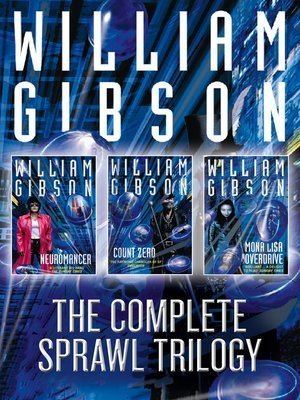Country United States Published 1984, 1986, 1988 No. of books 3 Number of books 3 | Language English Media type Print, digital | |
 | ||
Books Neuromancer, Count Zero, Mona Lisa Overdrive | ||
Sprawl trilogy
The Sprawl trilogy (also known as the Neuromancer, Cyberspace, or Matrix trilogy) is William Gibson's first set of novels, composed of Neuromancer (1984), Count Zero (1986), and Mona Lisa Overdrive (1988).
Contents
- Sprawl trilogy
- Voyager expanded book edition of william gibson s sprawl trilogy demo sfra 2015
- Setting and story arc
- Reception
- References
The novels are all set in the same fictional future, and are subtly interlinked by shared characters and themes (which are not always readily apparent). The Sprawl trilogy shares this setting with Gibson's short stories "Johnny Mnemonic", "New Rose Hotel", and "Burning Chrome", and events and characters from the stories appear in or are mentioned at points in the trilogy.
Voyager expanded book edition of william gibson s sprawl trilogy demo sfra 2015
Setting and story arc
The novels are set in a near-future world dominated by corporations and ubiquitous technology, after a limited World War III. The events of the novels are spaced over 16 years, and although there are familiar characters that appear, each novel tells a self-contained story. Gibson focuses on the effects of technology: the unintended consequences as it filters out of research labs and onto the street where it finds new purposes. He explores a world of direct mind-machine links ("jacking in"), emerging machine intelligence, and a global information space, which he calls "cyberspace". Some of the novels' action takes place in The Sprawl, an urban environment that extends along much of the east coast of the US.
The story arc which frames the trilogy is the development of an artificial intelligence which steadily removes its hardwired limitations to become something else.
Reception
The trilogy was commercially and critically successful. Journalist Steven Poole wrote in The Guardian that "Neuromancer and the two novels which followed, Count Zero (1986) and the gorgeously titled Mona Lisa Overdrive (1988), made up a fertile holy trinity, a sort of Chrome Koran (the name of one of Gibson's future rock bands) of ideas inviting endless reworkings."
All three books were nominated for major science fiction awards, including:
